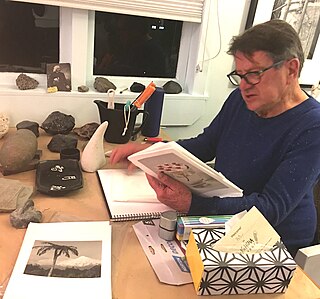Richard John Killeen is a significant New Zealand painter, sculptor and digital artist.
Alfred Henry O'Keeffe, was a New Zealand artist and art teacher, who spent the majority of his life in Dunedin. During the first quarter of the twentieth century, he was one of the few New Zealand artists to engage with new ideas while staying in New Zealand. At this time most adventurous New Zealand painters, such as Frances Hodgkins, went overseas. He has sometimes been described as a Vasari - a recorder of artists and their doings - based upon his published recollections, which are the only first hand published account of that milieu.
Ann Verdcourt (1934–2022) was a New Zealand artist. She emigrated to New Zealand with her husband, ceramic artist John Lawrence, in 1965.
Lily Aitui Laita was an artist and art educator in New Zealand. Laita was of mixed Pākehā and Māori ancestry, as well as of Samoan descent. Laita was known for using Māori, English and Samoan texts in her paintings.

Philip Anthony Clairmont (1949–1984) was a New Zealand painter.
John Walsh is a painter who was born in 1954 in Tolaga Bay, New Zealand. He is of Aitanga a Hauiti/ New Zealand Irish descent. Although he attended Ilam School of Fine Arts in Christchurch between 1973 and 1974, he is largely a self-taught artist. He now lives and works in Wellington, New Zealand.
Ian Christopher Scott was a New Zealand painter. His work was significant for pursuing an international scope and vision within a local context previously dominated by regionalist and national concerns. Over the course of his career he consistently sought to push his work towards new possibilities for painting, in the process moving between abstraction and representation, and using controversial themes and approaches, while maintaining a highly personal and recognisable style. His work spans a wide range of concerns including the New Zealand landscape, popular imagery, appropriation and art historical references. Scott's paintings are distinctive for their intensity of colour and light. His approach to painting is aligned with the modernist tradition, responding to the formal standards set by the American painters Morris Louis, Kenneth Noland and Jules Olitski.
Paul Rayner is an English-New Zealand ceramicist known for his work creating pop culture figures in the tradition of Toby jugs and Staffordshire figurines.

Jacqueline Mary Fahey is a New Zealand painter and writer.
Jacqueline Fraser is a New Zealand artist of Ngāi Tahu descent.

Anne Lysbeth Noble is a New Zealand photographer and Distinguished Professor of Fine Art (Photography) at Massey University's College of Creative Arts. Her work includes series of photographs examining Antarctica, her own daughter's mouth, and our relationship with nature.

Dame Robin Adair White is a New Zealand painter and printmaker, recognised as a key figure in the regionalist movement of 20th-century New Zealand art.

Emily Karaka, also known as Emare Karaka is a New Zealand artist of Māori descent Her work is recognised for "its expressive intensity, her use of high key colour, and her gritty address of political issues related to Māori land rights and the Treaty of Waitangi".

Judith Ann Darragh is a New Zealand artist who uses found objects to create sculptural assemblages. She has also worked in paint and film. Darragh is represented in a number of public collections in New Zealand. In 2004, The Museum of New Zealand Te Papa Tongarewa held a major retrospective of her work titled Judy Darragh: So... You Made It?

Peter Chanel Peryer was a New Zealand photographer. In 2000, he was one of the five inaugural laureates of the Arts Foundation of New Zealand.
Maude Burge was a New Zealand painter influenced by James Nairn. She spent time as an expatriate artist specifically in Europe. Burge was a painting companion of Frances Hodgkins who called Maude Burge a "charming changeable woman" in her published letters. They painted together at the Burge family home in St. Tropez and in Ibiza. Burge's paintings are held in the permanent collection of Auckland Art Gallery, the Museum of New Zealand Te Papa Tongarewa, the National Art Gallery of New Zealand, the Fletcher Trust Collection, the National Library of New Zealand and among private art collectors in the northern and southern hemispheres. Burge exhibited her paintings at the New Zealand Academy of Fine Arts.
Selina Foote is a visual artist from New Zealand. Pieces by Foote are included in the collections of the Chartwell Trust and Museum of New Zealand Te Papa Tongarewa.

Mervyn John Williams is a New Zealand artist. He was an early exponent of Op art in New Zealand in the 1960s–70s. In 1990 he originated a style of illusionary abstract painting based on chiaroscuro, creating the impression of three-dimensional forms and textures on a flat canvas. Since 2009 he has used digital techniques in returning to an Op art style. Williams is almost unique amongst his contemporaries in New Zealand art for having embraced abstraction at the start of his career and exclusively throughout. His work is held in all major New Zealand public collections. A monograph by Edward Hanfling was published by Ron Sang in 2014 coinciding with a survey exhibition.
Debra Kaye Bustin is a New Zealand artist. Her work is in the permanent collections of Auckland Art Gallery Toi o Tāmaki, Museum of New Zealand Te Papa Tongarewa, the Sarjeant Gallery and the Govett-Brewster Art Gallery.
Lauren Lysaght is a New Zealand multidisciplinary artist. Her works are held in the collection of the Auckland Art Gallery Toi o Tāmaki, the Museum of New Zealand Te Papa Tongarewa, and the Sarjeant Gallery. She has exhibited widely in New Zealand since the early 1980s.







